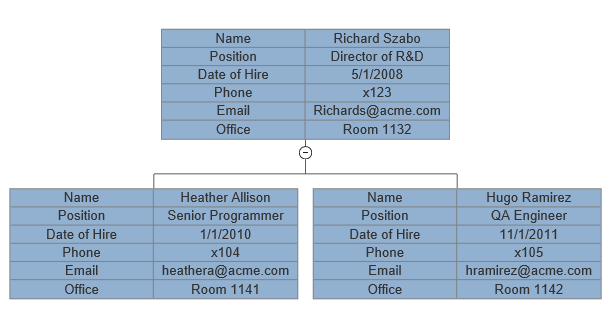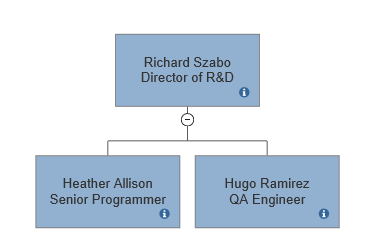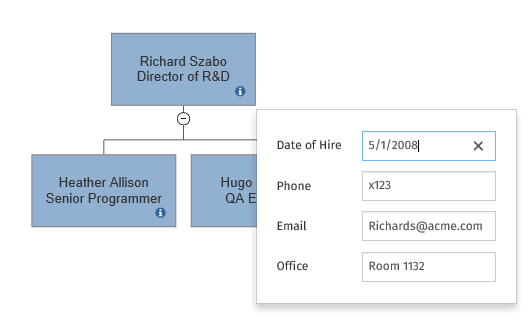{
myShape.SetTextTruncate(20);
}
When building a diagram from data, a shape often represents a data record and often data records have multiple fields, each with a different value.
The simplest approach is just to show one value that identifies the record in the shape. For example in a flowchart of a workflow show the name of the step in the shape as a "Label". But what if you want to show two or more field values in a shape? One way to do this is using a table:
Any shape can be subdivided into a table of cells by dividing it into rows and columns using the shape's AddTable() method. This takes the number of rows and columns as required arguments.
{
var myTable=myShape.AddTable(NRows,NColumns);
}
{
var myTable=myShape.AddTable(3,2);
}
Each of the six cells in this table can have its own "Label", colors etc, just like a shape.
{
var myTable=myShape.AddTable(3,1);
var myCell1=myTable.AddCell(1,1);
myCell1.SetLabel("Value1");
var myCell2=myTable.AddCell(2,1);
myCell2.SetLabel("Value2");
}
Tables are very flexible and making them look the way you want is explained in the Table section of this cookbook.
A second way to show multiple values in a shape is to concatenate the values on separate lines.
The \n in a text string creates a new line.
{
myShape.SetLabel("Value1\nValue2");
}
If a shape represents a record with many values it becomes less practical to show them all in the shape itself, even using tables. A third alternative is to show some of the values in a tool tip using Shape Data.
Compare this complicated org chart:

with the same example using shape data:

Hovering over the small "i" icon on each shape displays a tool tip that shows the additional data without cluttering up the visual:

Read more about Shape Data with VisualScript.
Adding a title to your diagram is accomplished by adding a "Title" object to your VisualScript object.
{
var myTitle=myDocument.AddTitle("This is a title");
myTitle.SetTextSize(18);
}
The Title object contains a Label and can be styled with the standard text properties. Entering /n in the label text causes a line break.
The title is centered above the diagram.
{
var myDocument= new VS.Document();
var myTitle=myDocument.AddTitle("A Simple Flowchart with a Return");
myTitle.SetTextSize(18);
var rootShape=myDocument.GetTheShape();
var myConnector=rootShape.AddShapeConnector("Flowchart");
myConnector.SetEndArrow(VS.Arrowheads.Filled).SetTextSize(18).SetTextColor("#FF0000");
var myShape1=myShapeConnector.AddShape();
myShape1.SetLabel("Shape A").SetLineLabel("label A").SetID(1);
var myShape2=myShapeConnector.AddShape();
myShape2.SetLabel("Shape B").SetLineLabel("label B").SetID(21);
var myReturn=myDocument.AddReturn(1,21);
myReturn.SetLabel("Repeat");
}
